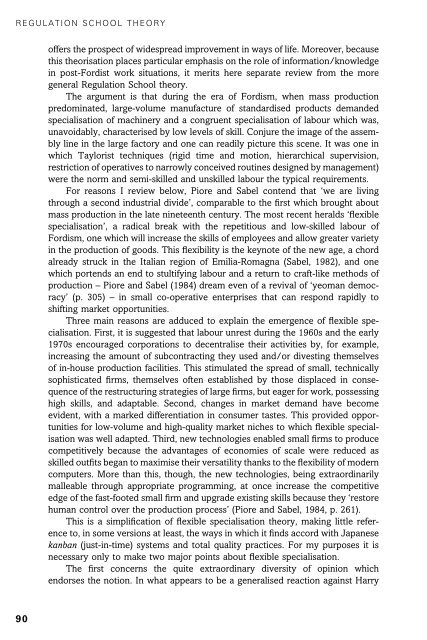Theories of the Information Society, Third Edition - Cryptome
Theories of the Information Society, Third Edition - Cryptome
Theories of the Information Society, Third Edition - Cryptome
Create successful ePaper yourself
Turn your PDF publications into a flip-book with our unique Google optimized e-Paper software.
REGULATION SCHOOL THEORY<br />
<strong>of</strong>fers <strong>the</strong> prospect <strong>of</strong> widespread improvement in ways <strong>of</strong> life. Moreover, because<br />
this <strong>the</strong>orisation places particular emphasis on <strong>the</strong> role <strong>of</strong> information/knowledge<br />
in post-Fordist work situations, it merits here separate review from <strong>the</strong> more<br />
general Regulation School <strong>the</strong>ory.<br />
The argument is that during <strong>the</strong> era <strong>of</strong> Fordism, when mass production<br />
predominated, large-volume manufacture <strong>of</strong> standardised products demanded<br />
specialisation <strong>of</strong> machinery and a congruent specialisation <strong>of</strong> labour which was,<br />
unavoidably, characterised by low levels <strong>of</strong> skill. Conjure <strong>the</strong> image <strong>of</strong> <strong>the</strong> assembly<br />
line in <strong>the</strong> large factory and one can readily picture this scene. It was one in<br />
which Taylorist techniques (rigid time and motion, hierarchical supervision,<br />
restriction <strong>of</strong> operatives to narrowly conceived routines designed by management)<br />
were <strong>the</strong> norm and semi-skilled and unskilled labour <strong>the</strong> typical requirements.<br />
For reasons I review below, Piore and Sabel contend that ‘we are living<br />
through a second industrial divide’, comparable to <strong>the</strong> first which brought about<br />
mass production in <strong>the</strong> late nineteenth century. The most recent heralds ‘flexible<br />
specialisation’, a radical break with <strong>the</strong> repetitious and low-skilled labour <strong>of</strong><br />
Fordism, one which will increase <strong>the</strong> skills <strong>of</strong> employees and allow greater variety<br />
in <strong>the</strong> production <strong>of</strong> goods. This flexibility is <strong>the</strong> keynote <strong>of</strong> <strong>the</strong> new age, a chord<br />
already struck in <strong>the</strong> Italian region <strong>of</strong> Emilia-Romagna (Sabel, 1982), and one<br />
which portends an end to stultifying labour and a return to craft-like methods <strong>of</strong><br />
production – Piore and Sabel (1984) dream even <strong>of</strong> a revival <strong>of</strong> ‘yeoman democracy’<br />
(p. 305) – in small co-operative enterprises that can respond rapidly to<br />
shifting market opportunities.<br />
Three main reasons are adduced to explain <strong>the</strong> emergence <strong>of</strong> flexible specialisation.<br />
First, it is suggested that labour unrest during <strong>the</strong> 1960s and <strong>the</strong> early<br />
1970s encouraged corporations to decentralise <strong>the</strong>ir activities by, for example,<br />
increasing <strong>the</strong> amount <strong>of</strong> subcontracting <strong>the</strong>y used and/or divesting <strong>the</strong>mselves<br />
<strong>of</strong> in-house production facilities. This stimulated <strong>the</strong> spread <strong>of</strong> small, technically<br />
sophisticated firms, <strong>the</strong>mselves <strong>of</strong>ten established by those displaced in consequence<br />
<strong>of</strong> <strong>the</strong> restructuring strategies <strong>of</strong> large firms, but eager for work, possessing<br />
high skills, and adaptable. Second, changes in market demand have become<br />
evident, with a marked differentiation in consumer tastes. This provided opportunities<br />
for low-volume and high-quality market niches to which flexible specialisation<br />
was well adapted. <strong>Third</strong>, new technologies enabled small firms to produce<br />
competitively because <strong>the</strong> advantages <strong>of</strong> economies <strong>of</strong> scale were reduced as<br />
skilled outfits began to maximise <strong>the</strong>ir versatility thanks to <strong>the</strong> flexibility <strong>of</strong> modern<br />
computers. More than this, though, <strong>the</strong> new technologies, being extraordinarily<br />
malleable through appropriate programming, at once increase <strong>the</strong> competitive<br />
edge <strong>of</strong> <strong>the</strong> fast-footed small firm and upgrade existing skills because <strong>the</strong>y ‘restore<br />
human control over <strong>the</strong> production process’ (Piore and Sabel, 1984, p. 261).<br />
This is a simplification <strong>of</strong> flexible specialisation <strong>the</strong>ory, making little reference<br />
to, in some versions at least, <strong>the</strong> ways in which it finds accord with Japanese<br />
kanban (just-in-time) systems and total quality practices. For my purposes it is<br />
necessary only to make two major points about flexible specialisation.<br />
The first concerns <strong>the</strong> quite extraordinary diversity <strong>of</strong> opinion which<br />
endorses <strong>the</strong> notion. In what appears to be a generalised reaction against Harry<br />
90
















